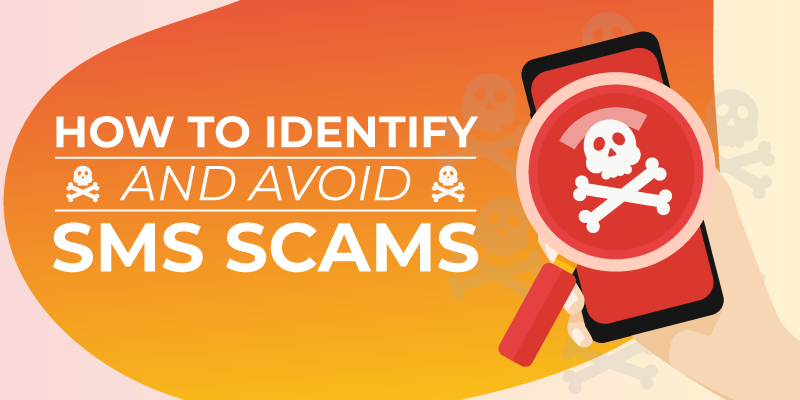Today, I will show you how to identify and avoid SMS scams. Also, I will add an infographic as well.
The digital age has ushered in an era of unparalleled convenience. Our smartphones, once a novelty, have become an extension of ourselves, serving as organizers, communication hubs, and gateways to information.
However, this convenience has a dark side: the rise of sophisticated scams and phishing attempts targeting these devices. Short Message Service (SMS), commonly known as texting, has become a prime battleground for these malicious actors.
This guide equips you with the knowledge to combat SMS scams and protect yourself from their deceptive tactics. We’ll delve into the signs of these scams, explore preventative measures, and provide actionable tips to secure your information and finances.
Table of Contents
The Rise of SMS Scams
SMS scams, also known as smishing (SMS phishing), exploit text messages to trick unsuspecting users into revealing personal information, clicking on malicious links, or sending money. These scams can have devastating consequences, leading to identity theft, financial loss, and even emotional distress.
The allure of SMS scams lies in their ability to appear legitimate. Scammers often employ various techniques to manipulate users, including:
- Social Engineering: They exploit psychological tactics to create a sense of urgency, fear, or excitement, prompting users to react impulsively without due diligence.
- Spoofing: Scammers can manipulate the sender’s information to make it appear as if the message comes from a legitimate source, such as a bank, government agency, or well-known company.
- Sense of Scarcity: They might create a sense of urgency by claiming your account is locked, a limited-time offer expires, or a package requiring immediate payment.
The prevalence of SMS scams highlights the importance of cybersecurity awareness. Understanding how these scams work and recognizing the red flags can significantly reduce your risk of becoming a target.
READ ALSO: 12 Common Online Scam Tactics: Shielding Yourself from Digital Deception
Warning Signs of SMS Scams
Here are some key warning signs to be on the lookout for when you receive a text message:
- Urgency and Pressure: Does the message create a sense of urgency or pressure to act immediately? Scammers often use scare tactics to cloud your judgment and prevent you from thinking critically.
- Requests for Personal Information: Be wary of messages asking for personal details like your Social Security number, bank account information, passwords, or online account credentials. Legitimate institutions rarely request such information via text message.
- Suspicious Links: Avoid clicking on links embedded within SMS messages, especially those from unknown senders. Clicking on these links might redirect you to phishing websites that steal your information or infect your device with malware.
- Grammar and Spelling Errors: Grammatical errors, typos, and unprofessional language are often hallmarks of scam messages. Legitimate businesses typically maintain high standards for communication.
- Offers That Seem Too Good to Be True: Beware of messages promising extravagant prizes, unbelievable discounts, or sudden financial windfalls. These are classic tactics used to lure unsuspecting victims.
- Unexpected Fees or Charges: Do not respond to messages demanding immediate payment for unforeseen fees or charges, especially if you haven’t authorized such charges.
READ ALSO: How To Read Someone’s Text MessagesSomeone’sTheir Phone
Essential Tips to Avoid SMS Scams
By incorporating these practical tips into your daily routine, you can significantly reduce your vulnerability to SMS scams:
- Verification is Key: If a text message appears to be from a legitimate source, such as your bank or credit card company, don’t respond directly to the message. Instead, contact the organization directly through a verified phone number or website to confirm its authenticity.
- Don’t Engage with UnknoDon’tmbers: Avoid responding to text messages from unknown numbers, particularly those that seem suspicious. Silence unknown numbers or report them to your mobile carrier.
- Strengthen Your Passwords: Use strong and unique passwords for all your online accounts and enable two-factor authentication (2FA) whenever possible. This adds an extra layer of security to prevent unauthorized access even if your password is compromised.
- Beware of Spoofing: Be skeptical of any message, even if it appears to come from a familiar number. Scammers can spoof phone numbers to make them seem legitimate.
- Educate Yourself: Stay informed about the latest scam tactics by following reputable cybersecurity resources. Share this knowledge with your loved ones to spread awareness and protect them.
- Report Suspicious Activity: If you receive a suspicious text message, consider reporting it to your mobile carrier or relevant authorities. This can help them track down scammers and prevent others from falling victim.
- Anti-Spam Applications: Consider using anti-spam applications that filter out suspicious text messages and protect you from potential threats.
READ ALSO: What Are Phishing Scams And How You Can Avoid Them?
Beyond Text Messages: Expanding Your Cybersecurity Awareness
While SMS scams are a prevalent threat, it’s crucial to remember that cybersecurity goes beyond text messages.
Here are some additional areas to consider fortifying your digital defenses:
Email Phishing: Phishing emails are a common tactic where scammers impersonate legitimate institutions like banks, social media platforms, or online retailers. These emails often contain malicious links or attachments that can steal your personal information or infect your device with malware. Be cautious of unsolicited emails; don’t click on suspicious links or attachments; verify the sender’s address before sending them.
Social Media Scams: Social media platforms are breeding grounds for various scams. Scammers might create fake profiles to impersonate friends, celebrities, or companies. They might also use social engineering tactics to manipulate you into revealing personal information, clicking on malicious links, or sending money. Be cautious of friend requests from unknown individuals, verify the legitimacy of profiles before interacting, and be mindful of what information you share publicly.
Malicious Apps: Download apps only from trusted sources like official app stores. Read reviews before installing an app, and be wary of apps that request excessive permissions. Keep your apps updated to benefit from the latest security patches.
Public Wi-Fi: Public Wi-Fi networks are convenient but can be insecure. Avoid accessing sensitive information like bank accounts or online financial portals while connected to public Wi-Fi. If you must use public Wi-Fi, consider using a Virtual Private Network (VPN) to encrypt your internet traffic and add an extra layer of security.
Physical Security: Cybersecurity isn’t just about digitaisn’teats. Be mindful of your physical surroundings as well. Don’t leave your phone Don’tptop unattended in public places, and be careful about what information you discuss in earshot of others.
Regular Backups: Back up your essential data on an external hard drive or cloud storage service. In case of a cyberattack or device failure, having a backup ensures you don’t lose critical information.
Conclusion
The digital age offers immense opportunities for connection, information, and convenience. However, it also presents new challenges in the form of cyber threats.
By understanding the tactics used in SMS scams and expanding your cybersecurity awareness, you can become a more informed and secure digital citizen.
Empower yourself and your loved ones with knowledge. Share this information and encourage open conversations about cybersecurity. Working together can create a safer and more secure online environment for everyone.
RELATED POSTS
- Tesco’ Free 4K TV’ PhisTesco’ am Targets’UK Shoppers
- How To Recognize And Avoid A Fake Virus And Malware Warning
- Changing Texts To Audio: Practical Uses Of Text To Speech
- What Next After Being Scammed Online?
- Why End-to-End Email Encryption Is the Way To Go
- How To Get German Virtual Number And Receive SMS Online
About the Author:
Daniel Segun is the Founder and CEO of SecureBlitz Cybersecurity Media, with a background in Computer Science and Digital Marketing. When not writing, he's probably busy designing graphics or developing websites.
Meet Angela Daniel, an esteemed cybersecurity expert and the Associate Editor at SecureBlitz. With a profound understanding of the digital security landscape, Angela is dedicated to sharing her wealth of knowledge with readers. Her insightful articles delve into the intricacies of cybersecurity, offering a beacon of understanding in the ever-evolving realm of online safety.
Angela's expertise is grounded in a passion for staying at the forefront of emerging threats and protective measures. Her commitment to empowering individuals and organizations with the tools and insights to safeguard their digital presence is unwavering.









